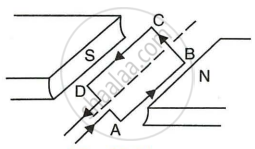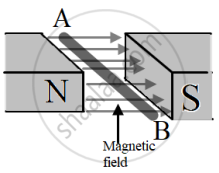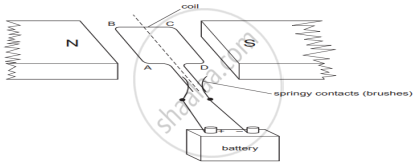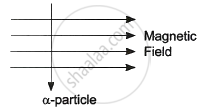Advertisements
Advertisements
Question
Observe the following figure:

If the current in the coil A is changed, will some current be induced in the coil B? Explain.
Solution
A current will be induced in Coil B. When there is a change in the current in Coil A, a magnetic field is associated with it. This induces a potential difference between the two coils which gives rise to a current in Coil B. This change can be noted by observing the deflection in the galvanometer.
APPEARS IN
RELATED QUESTIONS
The magnetic field inside a long straight solenoid-carrying current ______.
When is the force experienced by a current-carrying conductor placed in a magnetic field largest?
State the rule to determine the direction of a force experienced by a current-carrying straight conductor placed in a magnetic field which is perpendicular to it.
What concealed do you get from the observation that a current-carrying wire deflects a compass needle placed near it?
Draw a sketch to show the magnetic lines of force due to a current-carrying straight conductor.
State and explain the Clock face rule for determining the polarities of a circular wire carrying current.
Name any two factors on which the strength of magnetic field produced by a current-carrying solenoid depends. How does it depend on these factors?
What type of core should be put inside a current-carrying solenoid to make an electromagnet?
The diagram given below represents magnetic field caused by a current-carrying conductor which is:

(a) a long straight wire
(b) a circular coil
(c) a solenoid
(d) a short straight wire
The magnetic field lines in the middle of the current-carrying solenoid are?
(a) circles
(b) spirals
(c) parallel to the axis of the tube
(d) perpendicular to the axis of the tube
A current-carrying straight wire is held in exactly vertical position. If the current passes through this wire in the vertically upward direction, what is the direction of magnetic field produced by it? Name the rule used to find the direction of magnetic field.
What happens when a current-carrying conductor is placed in a magnetic field?
For Fleming's left-hand rule, write down the three things that are 90° to each other, and next to each one write down the finger or thumb that represents it.
State Fleming's left-hand rule. Explain it with the help of labelled diagrams.
A current flows in a wire running between the S and N poles of a magnet lying horizontally as shown in Figure below:
The force on the wire due to the magnet is directed:

fron N to S
from S to N
vertically downwards
vertically upwards
In the simple electric motor of figure given below, the coil rotates anticlockwise as seen by the eye from the position X when current flows in the coil

Is the current flowing clockwise or anticlockwise around the coil when viewed from above?
If the current in a wire is flowing in the vertically downward direction and a magnetic field is applied from west to east, what is the direction of force in the wire?
What is the force on a current-carrying wire that is parallel to a magnetic field? Give reason for your answer.
force experienced by a current-carrying straight conductor placed in a magnetic field which is perpendicular to it.
Two coils A and B of insulated wire are kept close to each other. Coil A is connected to a galvanometer while coil B is connected to a battery through a key. What would happen if:
the current is stopped by removing the plug from the key?
Explain your answer mentioning the name of the phenomenon involved.
State condition when magnitude of force on a current carrying conductor placed in a magnetic field is zero?
State condition when magnitude of force on a current carrying conductor placed in a magnetic field is maximum?
Name and state the law which is used to determine the direction of force on a current carrying conductor placed in a magnetic field.
A coil ABCD mounted on an axle is placed between the poles N and S of a permanent magnet as shown in Figure.

- In which direction will the coil begin to rotate when current is passed through the coil in direction ABCD by connecting a battery at the ends A and D of the coil?
- Why is a commutator necessary for continuous rotation of the coil?
- Complete the diagram with commutator, etc. for the flow of current in the coil?
Name the following diagram and explain the concept behind it.

The following diagram shows two parallel straight conductors carrying the same current. Copy the diagram and draw the pattern of the magnetic field lines around them showing their directions. What is the magnitude of the magnetic field at a point 'X' which is equidistant from the conductors? Give justification for your answer.

The strength of magnetic field around a current-carrying conductor is ____________.
When current is parallel to a magnetic field, then force experience by the current-carrying conductor placed in a uniform magnetic field is ____________.
Which of the following factors affect the strength of force experience by current-carrying conduct in a uniform magnetic field?
The diagram below shows a free conductor AB is kept in a magnetic field and is carrying current from A to B. (To avoid confusion complete path of the circuit is not shown) The direction of the force experienced by the conductor will be:

What does the direction of thumb indicate in the right-hand thumb rule. In what way this rule is different from Fleming’s left-hand rule?
A simple motor is made in a school laboratory. A coil of wire is mounted on an axle between the poles of a horseshoe magnet, as illustrated.

In the example above, coil ABCD is horizontal and the battery is connected as shown.
- For this position, state the direction of the force on the arm AB.
- Why does the current in the arm BC not contribute to the turning force on the coil?
Observe the given figure of Fleming's Left Hand Rule and write the labels of 'A' and 'B':

An alpha particle enters a uniform magnetic field as shown. The direction of force experienced by the alpha particle is ______.

